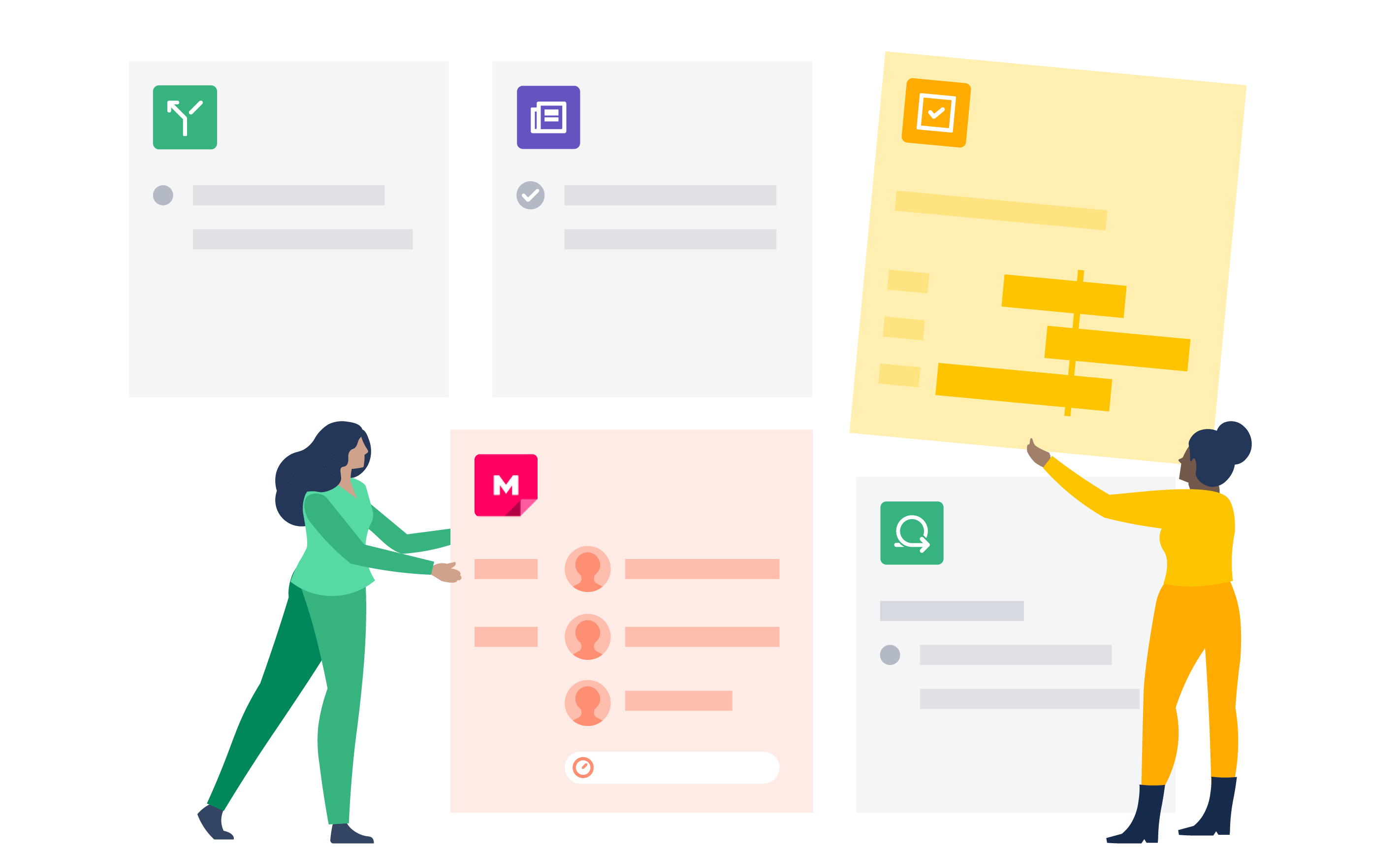KPI (主要業績指標) とは
トピック一覧
自社のビジネスとそのプロジェクトが実際に成功しているかどうかは、どのように測定できるでしょうか? 忙しいと感じ、従業員も懸命に取り組み、常に顧客を獲得できていたとしても、感覚や観察には騙されることがあります。パフォーマンスを測定しなければ、ビジネスが成功しているかどうかが把握できずリスクにさらされることになります。
幸い、パフォーマンスは、目的達成に向けて順調に進んでいるのか、調整が必要なのかを示す KPI (主要業績指標) を使用して測定することができます。直感を具体的なデータに変換して、本能だけに頼るのではなく、情報に基づいた意思決定が可能になります。
小規模チームと大企業のどちらを主導している場合でも、KPI とその使用方法を理解することが、意思決定を直感に頼るのか、確かなデータに基づいて下すのかの分かれ目になります。このガイドでは、KPI を選択する方法やビジネス全体への実装方法などについて、詳しく説明します。
成功を追跡したいのなら、今すぐ Confluence で KPI テンプレートを作成しましょう。
KPI とは
主要業績指標は、ビジネスやプロジェクトの目標をどの程度効果的に達成しているかを示すために、慎重に選ばれた指標です。それぞれの KPI は、ビジネスの健全性に関する重要なポイントを示します。
優れた KPI にはすべて、主に次のような特徴があります。
- ビジネス目標と一致している
- 明確に定義され、測定可能である
- 実行可能でビジネス上の意思決定を左右する
- 定期的に報告するものとして、期限がある
-
成果の責任者がアクセスできる
KPI はさまざまな事業分野で利用されており、チームが得られるインサイトもそれぞれ異なります。営業チームはパイプラインの健全性を把握するために KPI を利用しており、どれだけ効果的に商談を成立させているかを示すコンバージョン率から、市場での成功を示す収益の伸びまで、あらゆるものを追跡しています。
マーケティング チームではキャンペーンの ROI を監視して支出に対する成果を得て、リードを生成して潜在的な顧客の健全なフローを維持できるようにします。カスタマー サービスでは、チームが対応時間と満足度スコアを通じてパフォーマンスを測定し、クライアントのニーズに効果的に応えられるようにします。
事業部門ではビジネス効率の要点に重点を置き、KPI によって生産性を測定し、プロセスを合理化します。また、財務チームは、収益性指標とキャッシュ フロー指標を介して会社の財政状態を追跡し、企業が強固な財務基盤を維持するようにします。
OKR と KPI の比較
パフォーマンスの測定は、どのビジネスにとっても不可欠なものですが、さまざまな追跡フレームワークの違いを理解しておくことが重要です。OKR と KPI の 2 つのアプローチは、しばしば混同されがちですが、その目的は根本的に異なります。
OKR と KPI の主な違いは、その中心的な機能です。KPI はビジネスの健全性と持続可能性を監視する継続的なバイタル サインであり、確立されたプロセスとその時点のパフォーマンス レベルを測定します。これは通常、時間が経過しても一貫性を保ち、チームの日々の意思決定に対して信頼性の高い、安定した指標を提供します。
一方、OKR は変革と革新を促進するものとして設計されています。通常は、野心的で向上心があり、チームが簡単には到達できない高みを目指す目標を設定するものになります。
KPI が現時点の市場シェアを追跡するものであれば、OKR はチームが 6 か月以内に 3 つの新しい市場に進出するものを求めるものになるでしょう。この違いを理解しておくことで、企業は現在のパフォーマンスを維持・最適化するための KPI と、成長と革新を促進するための OKR という両方のツールを効果的に活用できます。
KPI の重要性
KPI は、意思決定とパフォーマンス追跡の向上のために測定可能なデータを提供します。その重要性を理解しておくと、それを適切に実装し、可能な限り最高の結果を得られるようになります。次のような理由から、KPI は企業にとって不可欠なものです。
- 戦略的計画と意思決定: KPI は、直感的な意思決定をデータに基づく戦略に変えます。経営陣は、明確な業績指標にアクセスできれば、傾向を早期に特定し、より効果的にリソースを割り当て、直感ではなく実際のデータに基づいて戦略を調整できます。
- プロジェクトのコラボレーションと監視: Confluence のようなプロジェクト コラボレーション ツールを使って KPI を追跡すれば、チーム メンバー全員にとって信頼できる唯一の情報源になります。チームはパフォーマンスをリアルタイムで監視し、最新情報を効率的に共有し、目的に対する進捗を明確に把握できるようになります。
-
説明責任と改善: KPI を定期的に追跡することによって、指標のオーナーシップが明確になり、継続的な改善のための枠組みが生まれます。チームは、効果のあった戦略を特定して再現し、業績の優れない分野を迅速に探し出し、結果を改善するための果断な措置をとることができます。
KPI の種類
さまざまなタイプの KPI を理解しておくと、企業は特定の目的に適した指標を選択しやすくなります。KPI の各タイプは、業績のさまざまな側面を測定します。カテゴリについて知っておくべき点を以下に紹介します。
定量的 KPI
定量的 KPI は解釈の余地がほとんどなく、具体的かつ測定可能なデータを提供します。これらの指標はパフォーマンスを明確な数値に変換するので、進捗の追跡や長期にわたる結果の比較が容易になります。
たとえば、収益の伸び率は事業がどれだけ拡大しているかを正確に測定するものであり、財務上の進歩を直接的に示しています。同様に、顧客獲得コストは、マーケティングと販売の効率を評価する正確な数値です。これらの客観的な測定値は意思決定の強固な基盤となり、業績に関する明確なデータを提供します。
定性的 KPI
定性的 KPI は、定量的 KPI ほど簡単には定量化できませんが、数値だけでは伝えられない業績の重要な側面を捉えます。CSAT (顧客満足度) スコアは、企業が自社サービスや製品エクスペリエンスの質の理解に役立ち、従業員のエンゲージメント レベルは、職場の文化やチームの士気に関するインサイトを明らかにします。
これらの指標のほとんどはアンケートやフィードバックに基づいていますが、ビジネスの成功を促進する人的な要素に関して、貴重な視点を提供します。このような主観的な尺度を追跡することで、企業は業務の経験的側面を深く理解し、改善できます。
主要 KPI
主要な KPI は早期警告システムとして機能し、企業が将来の結果を予測し、それに応じて方針を調整するのに役立ちます。これらの将来を見据えた指標からは、将来の業績に関するインサイトが得られ、チームはプロアクティブに意思決定を行えるようになります。
たとえば、獲得した新しいリード数の追跡は今後の販売実績を予測する際に役立ち、Web サイトのトラフィック傾向の監視は将来の顧客エンゲージメント レベルを表します。このような予測の指標により、企業は潜在的な課題が収益に影響する前に対処することができます。
遅行 KPI
遅行 KPI は、すでに起こったことを表し、過去の業績と戦略の有効性に関する具体的な証拠を示します。毎月の収益合計や顧客解約率などの過去の指標は、企業が意思決定やイニシアチブの実際の影響を理解するのに役立ちます。
これらの指標は変更できませんが、将来の計画に役立つ貴重な教訓となり、特定の戦略が意図した結果を達成したかどうかを検証するのに役立ちます。企業はこれらの結果ベースの指標を分析し、今後さらに多くの情報に基づいた意思決定を行うことによって、アプローチを改善していくことができます。
財務 KPI
財務 KPI は、ビジネスの持続可能性と成功に関する重要なインサイトを提供します。このような ROI (投資収益率) や粗利益率をはじめとする指標は、企業がリソースからどれだけ効果的に価値を生み出しているかをわかりやすく可視化します。
企業は財務 KPI を慎重に監視することによって業務効率を評価し、リソース配分について情報に基づいた意思決定を行い、長期的な存続可能性を確保できます。これらの指標は、どれだけの資金が流入しているか、企業の労力がどれだけ効率的に財務結果に反映されているのかを経営陣が把握するのに役立ちます。
効果的な KPI を設定する方法
役立つ KPI を作成するには、プロセスを明確にしておく必要があります。SMART 目標のフレームワークを使用して始めましょう。
つまり、各 KPI は次のように設定する必要があります。
- 具体的: 1 つの明確な業績分野をターゲットにする
- 測定可能: 追跡できる実際の数値を使用する
- 達成可能: チームが達成できる現実的な目標を設定する
- 関連性がある: 実際のビジネス ニーズに結び付ける
-
期間が明確: 明確な締め切りを設定する
Confluence の SMART 目標テンプレートを出発点として使用します。
また、KPI は会社のより大きな目標とプロジェクトのスコープをサポートするものでなければなりません。適切な目標設定とは、すべての KPI を組織の目標に結び付けることです。会社が顧客満足度の向上を目指すのであれば、顧客の満足度に直接影響するものを測定する KPI を実装する必要があります。目的が売上増加であれば、その KPI は収益増加につながる活動を追跡するものでなければなりません。
実際の例としては、あるカスタマー サービス チームが対応時間の短縮を目指しているとします。不適切な KPI は「顧客に迅速に対応する」のようになりますが、適切な KPI は、「6 月 30 日まで、営業時間中はすべての顧客からのメッセージに 2 時間以内に返信する」といったものです。このように、何をすべきか、どのように測定するか、いつ何を達成するかが明確にされていると効果があります。
KPI を測定・分析する方法
チームは、効果的なプロジェクト計画のために、複数のツールを使用して KPI を設定し、追跡できます。デジタル ダッシュボードには、リアルタイムのデータと進捗が表示され、スプレッドシートは、詳細なデータ分析と履歴の追跡に役立ちます。プロジェクト管理ソフトウェアは、追跡とチームの調整を組み合わせます。分析プラットフォームでは、Web と顧客の指標に関する深いインサイトが得られます。
Confluence は、これらすべての要素をカスタマイズ可能なダッシュボードおよびテンプレートと組み合わせて、KPI を一元的に管理します。これにより、データの収集、最新情報の共有、全員による進捗の把握が容易になります。
KPI の効果的な利用には、定期的な分析が不可欠です。毎週、または毎月のレビューを設定して、目標を達成しているかどうかを確認します。達成できないようならアプローチを調整します。目標を超えている場合は、さらに厳しい目標を設定してもよいかもしれません。KPI は固定のものではありません。ビジネス ニーズの変化に応じて進化させてください。
KPI のメリットとデメリット
他のビジネス ツールと同様に、KPI にはメリットとデメリットがあります。KPI のメリットには次のものがあります。
- 適切な意思決定: チームは、直感ではなく実際のデータに基づいてビジネス上の意思決定を行うことができます。
- 明確な目標の追跡: 達成までの距離を全員が正確に把握します。
- 早期警告システム: 問題がさらに大きな課題に発展する前に可視化します。
- チームワークの向上: チームが共通の指標に基づいて足並みを揃えます。
- 従業員のモチベーション: 明確な目標があると、成功とはどのようなものかを理解するのに役立ちます。
業績の可視性: 企業全体で進捗を確認し、共有しやすくします。
KPI は便利なものですが、次のようにチームが注意すべき課題が生まれる場合もあります。
- 複雑すぎる: 追跡する指標が多すぎると、重要なものに集中できなくなる場合があります。
- 間違った指標: 間違った KPI を選択すると、チームが間違ったアクティビティに注力してしまう可能性があります。
- 時間への投資: データの収集と分析に多大な労力がかかります。
- 数値への固執: チームが数値にこだわりすぎ、質的な要素を忘れることがあります。
- 制度の抜け穴: 実質的な改善を得なくても目標を達成する方法を見つけてしまう場合があります。
変化への抵抗: チーム メンバーの中には、測定されることに抵抗を示す人もいます。
KPI の例
業界が異なれば、具体的な目標に基づいて追跡する KPI も異なります。結果を左右する KPI の一般的な例を次に示します。
ソフトウェア チームと IT チーム
ソフトウェア チームと IT チームは、システムの健全性と開発効率を明らかにする指標に焦点を当てています。主要な IT KPI には、チームがどれだけ迅速に作業を完了するかを追跡するための開発のベロシティ、課題の解決速度を測定するためのバグ解決時間、サービスの信頼性を監視するためのシステム稼働時間などがあります。
インシデント対応では、チームは解決までの平均時間、繰り返し発生するインシデントの数、顧客への影響時間などのインシデント管理 KPI を使用してシステムの安定性を高め、混乱を最小限に抑えます。
プロダクトマネジメント
プロダクト マネジメント KPI では、製品の成功とユーザー満足度を示す指標を追跡します。チームは、機能を積極的に利用している顧客の数を示すユーザーの導入率、ユーザーの満足度を測定する CSAT スコア、製品の収益化を追跡する顧客 1 人あたりの収益を監視します。
カスタマー サービス
カスタマー サービス チームでは、サービスの質と効率を測定する指標に焦点を当てます。迅速な顧客確認のための最初の応答時間、サービスのスピードを監視するためのチケット解決時間、サービスの質を測定するための CSAT スコア、人員配置のニーズを計画するためのチケット量の傾向を追跡します。
人事
人事チームは KPI によって労働力の健全性と組織の有効性を監視します。従業員の定着率を測定するための離職率、採用効率を高めるための採用までの時間、チームを開発するためのトレーニング修了率、職場の文化を評価するための従業員満足度スコアを追跡します。
KPI の効果的な管理のための Confluence の活用
Confluence では、KPI の追跡と管理が、あらゆる規模のチームにとってのコラボレーション作業になります。カスタマイズ可能なダッシュボードを使えば、指標をリアルタイムで視覚化し、最新情報を即座に共有して、全員が進捗を把握できるようになります。プラットフォームに組み込まれているテンプレートとレポート ツールを使用すれば、複数のチーム全体で KPI の追跡と測定方法を標準化し、パフォーマンス監視を一貫性のあるものにして、明確に保つことができます。
各チームは動的な KPI レポートを作成し、自動追跡システムを設定し、すべてのパフォーマンス指標のための信頼できる唯一の情報源を確保することができます。チームは販売目標、顧客満足度スコア、あるいはプロジェクト マイルストーンのどれを監視しているかを問わず、Confluence のプロジェクト コラボレーション ツールによってデータ主導の意思決定を行えるようになります。Confluence を使用すれば、チームのナレッジを 1 か所に集約できます。
